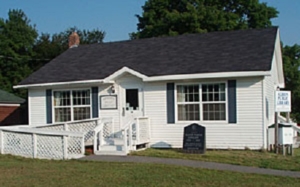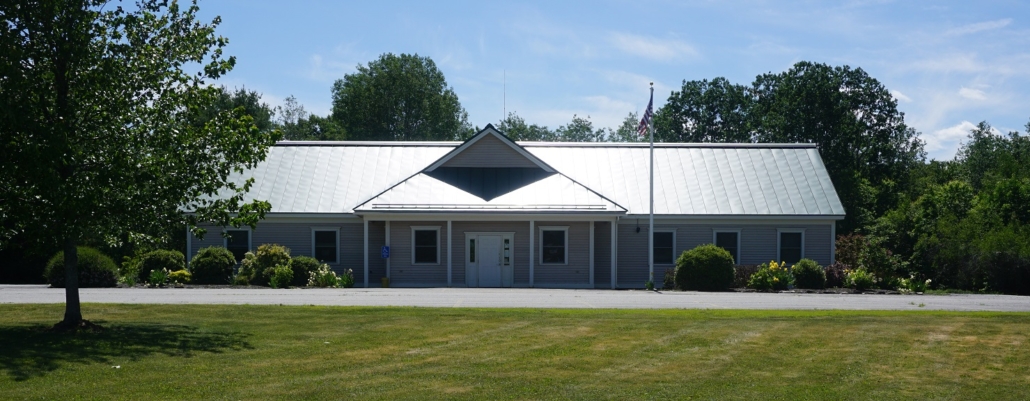Sheepscot courtesy boat inspectors
The 2020 Courtesy Boat Inspectors are now working weekend shifts at the boat launch at Sheepscot Lake, in Palermo. They are encouraging boaters to check their vessels for invasive plants before entering the lake.

The 2020 Courtesy Boat Inspectors are now working weekend shifts at the boat launch at Sheepscot Lake, in Palermo. They are encouraging boaters to check their vessels for invasive plants before entering the lake.
 You need a break from the monotony. The Living Communities Foundation is bringing in big, drippingly-sweet peaches from northern New Jersey starting on July 31, with one or two more deliveries in August. The schedule isn’t set in stone yet, as details are still crystallizing. However, the first order has to be turned in and paid by July 24, so time is of the essence. The good news is that the price has not gone up! It’s still $37 for a 37 to 40-pound box or $23 for a half box. If you get together with friends and neighbors and order four or more boxes, you get a $2 discount per full box!
You need a break from the monotony. The Living Communities Foundation is bringing in big, drippingly-sweet peaches from northern New Jersey starting on July 31, with one or two more deliveries in August. The schedule isn’t set in stone yet, as details are still crystallizing. However, the first order has to be turned in and paid by July 24, so time is of the essence. The good news is that the price has not gone up! It’s still $37 for a 37 to 40-pound box or $23 for a half box. If you get together with friends and neighbors and order four or more boxes, you get a $2 discount per full box!
To order, email Connie Bellet at pwhitehawk@fairpoint.net and mention your daytime phone number for confirmation, and a call when the peaches arrive. Or you can call her at 993-2294 and leave a message with your name, phone, and preference of which Friday you can best pick up your peaches. Checks may be made out to LCF and sent to P.O. Box 151, Palermo, ME 04354. The peaches will arrive at the Palermo Community Center, on Veterans Way and Turner Ridge Rd., across from the ball field. You’ll see the electric sign. Our volunteers will place your boxes in your vehicle. To maintain social distance, please stay in your car. As the delivery dates are firmed up, you’ll get further emails. Thank you for your support!!!
Proceeds from this sale will go toward maintaining the Community Center, repairing the roof, and paying ongoing bills. The COVID pandemic has put a big dent in our normal fundraising, so your support is greatly appreciated!
The Sheepscot Lake Association hosted the second annual Independence Day boat parade, on Sheepscot Lake, on July 4, 2020. Over 25 decorated boats participated, with many others enjoying the festivities from the shore. (contributed photos)
As we navigate through the Covid-19 pandemic, the first phase of reopening the Palermo Community Library is to offer curbside pickup beginning Saturday, June 20, 2020. To protect the safety of our staff and patrons, the library will be following the guidelines of the Maine State Library and Maine CDC. Staff will wear masks and gloves while preparing your bags for check-out. Patrons and staff are expected to respect social distancing recommendations.
Procedure for pickup (see detailed description under ‘policies’ on website):
In the meantime, the trustees are working hard to prepare for the next phase of reopening by installing plexiglass hygiene barriers, providing a deep thorough cleaning of the library’s interior, and writing policies that will protect the health and safety of our staff and patrons. Hope to see you soon!

photo: vassalboro.net
The Vassalboro Public Library is reopened to the public during their regular hours. Monday and Friday noon – 6 p.m., and Wednesday and Saturday 10 a.m. – 4 p.m. They have a new ongoing book sale room that is open to the public. They will also host a partially virtual summer reading program for all ages. Please check their website for the Covid-19 policies.
The Oakland Public Library is now open. You may check out books, magazines and movies. There is a 30-minute time limit on visits, with a five item limit on loans. Computers are available.
Hand sanitizers are available upon entering and also at the service desks. Masks that cover the nose and mouth must be worn, and patrons must observe 6 foot physical distancing.
Hours are: Tuesday, 10 a.m. – 7 p.m., Wed., Thurs., Fri. 10 a.m. – 6 p.m.
For more information, call 465-7533.

Albion Public Library
The Albion Public Library will fill orders for books, audio books and DVDs. Simply go online to the Town of Albion website: townofalbionmaine.com, click on local links, Albion library, online, display.
Or, log-in: first initial and last name, patron #. Ex.: rmorin,123.
You can browse the materials they have in the library.
To order, they will need the author and title of the book, audio book or DVD.
Send this to bertajanc@roadrunner.com.
Be sure to include your telephone number. They will fill your order and make an appointment with you for pick up.

(Photo courtesy of Palermo Community Library)
The Palermo Community Library will broadcast its 18th annual meeting on Facebook Live Sunday, July 12, at 2 p.m. Trustee Andy Pottle will be filming/producing the online event.
Prior to the COVID-19 pandemic, the library had planned to host Captain David Sulin, a 20th Maine civil war re-enactor, to speak about Palermo residents in the civil war, specifically, the Battle of Gettysburg. He looks forward to giving this presentation in the future. The library will not have a speaker at this year’s event; it will be a customary business meeting including the election of officers. The public is invited to join the meeting virtually—check out Palermo Community Library on Facebook for details of how to participate.
Also, please note that the library has curbside pickup available for library materials. See the website for details: www.palermo.lib.me.us.
For more information call 993-6088 or email palermo@palermo.lib.me.us or visit www.palermo.lib.me.us.
Palermo is the only town in this series that is not in Kennebec County. The boundary line between China on the west and Palermo on the east is also the line between Kennebec and Waldo counties. It runs through Branch Mills, formerly Palermo’s main commercial center.
It is not Palermo residents’ fault that they don’t live in Kennebec County. In 1760, all of Maine was organized as Lincoln County; divisions since then have created the present 16 counties. In 1789, part of Lincoln County, not including current Palermo, became Hancock County. On Feb. 7, 1827, Waldo County was created from parts of Hancock and Lincoln counties and included Palermo.
On Feb. 23, 1827, historian Millard Howard says in An Introduction to the Early History of Palermo, Maine, (second edition, December 2015), Palermo voters unanimously asked the legislature to add them to Kennebec County. Their request was not granted.
Nor is Palermo part of the Kennebec River watershed. Instead, the town is doubly in the Sheeepscot River basin. Branch Pond and Branch Mills, on the western edge of the town, are on the West Branch of the Sheepscot, and Sheepscot Pond, which fills about a third of the southern half of Palermo, is on the main stem. The two rivers join well south of town, between Coopers Mills and North Whitefield.
A multitude of small ponds are scattered through northern Palermo; not all have names on the contemporary Google map. Named ponds include, in a northern tier and moving from east to west, Prescott, Nutter and Chisholm.
The next tier south, approximately east of Branch Pond, includes, from east to west, Bowler, Foster and Belden. South of them are Dowe Pond on the east, not far from Branch Mills; Saban Pond and to its south Bear Pond, about mid-way between the eastern and western boundaries; and Jump Pond, south of Foster Pond.
Beech Pond, near Greeley’s Corner (or Greely Corner, or Center Palermo) between Parmenter and Cain Hill roads, is the final named pond north of Route 3. South of the highway, Sheepscot Pond has a tiny nameless blue spot on the map to its northwest; Turner Pond, shared with Somerville, on its southwest; and on the southeast another blue spot identified as Deadwater Slough.
According to Howard, Stephen Belden, his wife Abigail and their son Aaron were Palermo’s first settlers, in 1769. Their second son, Stephen, Jr., was born in 1770, the first settlers’ child born in Palermo.
The Beldens chose not to homestead beside Sheepscot Great Pond, as Sheepscot Pond was then called. Howard suggests they chose a more secluded location because they were squatters with no legal title to the land and did not want visits from agents of the Kennebec Proprietors, owners of a large tract 15 miles on either side of the Kennebec River.
Howard locates the first Belden homestead only by late 20th century owners Robert and Susie Potter. Later, he said, the Beldens moved to the shore of what was then Belden, and later became Bowler, Pond.
Other people who arrived in the 1700s, according to Howard (who did a great deal of research in early documents) were Hollis Hutchins (1775), who, Howard says, settled “in the lower Turner Ridge area”; Jacob Greeley, Jr, (1777) and John Foye (1778), near Beech Pond; and Jonathan Bartlett (1788), who built the first sawmill on the Sheepscot south of Sheepscot Great Pond.
Other early names Howard mentions include Albee, Boynton, Bradstreet, Cressey, Lewis, Turner and Worthing. Ava Harriet Chadbourne’s Maine Place Names and the Peopling of Its Towns (1955) adds Bowler, Clay, Longfellow and Waters in the 1770s and 1780s. Many settlers had large families who intermarried through the generations. For example, Howard says Hollis Hutchins’ five sisters married into the Albee, Boynton, Cressey, Foye and Turner families.
The area was first called Sheepscot Great Pond Settlement. After an 1801 survey of 27,100 acres by William Davis of nearby Davistown (now Montville), it was organized as Sheepscot Great Pond Plantation. Howard says the first clerk of the plantation was a well-liked 24-year-old doctor from Vermont named Enoch P. Huntoon.
Immediately after the plantation was created, 55 residents asked the Massachusetts General Court to make it a town and to name it Lisbon. The requested name, Chadbourne and Howard explain, was part of a trend to name Maine towns after important foreign places – hence the famous Maine road sign that lists seven foreign countries honored in Maine plus Naples and Paris (but omits Belgrade, Lisbon, Palermo, Madrid, Rome, Sorrento and Verona Island).
The Lisbon on the sign is the Androscoggin County Lisbon between Lewiston and Brunswick, not the one requested in Waldo County. Lisbon was settled in 1628, its website says, and incorporated as Thompsonborough in June 1799. In December 1801 residents asked the Massachusetts legislators to
change the name to something less cumbersome, suggesting Lisbon. On Feb. 20, 1802 (after Sheepscot Great Pond’s petition was filed but before the legislature acted) Thompsonborough became Lisbon.
Sheepscot voters looked for another capital. They also realized that the P. in Dr. Huntoon’s name stood for Palermo. On June 23, 1804, the Massachusetts General Court approved the incorporation of the town of Palermo. Howard wonders if local residents realized Palermo in Sicily had been an important medieval center and, in his opinion, was a better choice than Lisbon.
Early transportation in Palermo was by the Sheepscot River and by trails. One of the functions of a town government was to lay out, build and maintain roads; Howard says Palermo officials were especially active from 1805 until about 1820. The first road linking the southern settlements with northern Palermo followed a route approximated by the present Turner Ridge Road (which joins Route 3 from the south at Greeley’s Corner, east of Beech Pond); Parmenter Road (which goes north off Route 3 west of Beech Pond); and Marden Hill Road (Parmenter Road’s name north of the four-way junction with Nelson Road and Belden Road). Marden Hill Road continues northeast to connect with North Palermo Road.
The southern end of town gradually lost importance. By the 1820s, Howard mentions five centers along or north of present Route 3: Branch Mills; Greeley’s Corner; Carr’s Corner on the North Palermo Road west of Prescott Pond; Ford’s Corner, where the North Palermo and Chisholm Pond roads meet; and East Palermo, the junction of Banton Road and Route 3.
A “center” would have at least one public building and/or business and a cluster of houses. The public building might be a post office; at various times, Branch Mills, Center Palermo, North Palermo and East Palermo had one. In the 1860s, Howard says, Greeley’s and Carr’s corners each had at least one store, at least one church and a school.
Howard found that Palermo reached its greatest growth in terms of population around 1850. He cites a series of census figures: 1790, 164 people counted; 1800, an almost threefold increase to 444; 1820, 1,056, the first count over 1,000; 1840, 1,594; 1850, the highest recorded, 1,659. A gradual decline began with a loss of almost 300 by 1860. By 1890, the population was again below 1,000, at 887. Howard’s list stops at 1950, when the population was recorded as 511. A steady increase began in 1970, and the 2010 census recorded 1,535 inhabitants, almost back to the pre-Civil War high.
The 1886 Gazetteer of the State of Maine says Branch Mills was then the largest village, with eight mills. Center Palermo had a “board and shingle-mill” and a stone quarry; East Palermo had two lumber mills; and North Palermo had a factory that made drag-rakes.
One of the mills in Branch Mills was the Dinsmore Grain Company Mill, on the China side of town. The mill building and its associated dam stretched across the Sheepscot River, with access to the building from the east shore.
The first mill on the site was built in 1817 by Joseph Hacker, according to a Wikipedia article. Hacker’s son-in-law, Jose Greely, succeeded him, and in 1879 Greely took his son-in-law, Thomas Dinsmore, as a partner. Thomas Dinsmore’s son James Roscoe Bowler Dinsmore succeeded him.
The 1908 fire that destroyed most of Branch Mills destroyed the mill as well. James R. B. Dinsmore rebuilt it in 1914 as a two-and-a-half-story wooden building, shingled, with a three-story tower on the south side. Initially it was only a grist mill, in 1935 James Kenneth Dinsmore (James R. B. Dinsmore’s son) added a sawmill operation, which continued until 1960.
On Nov. 3, 1979, the Dinsmore mill was added to the National Register of Historic Places. Subsequent owners proposed reusing it, but none succeeded. Both the building and the dam deteriorated, to the point where waterfront property owners on upstream Branch Pond complained that the dam no longer kept water levels high enough for recreation. The Maine Department of Environmental Protection also objected that its water level regime for Branch Pond was violated.
By 2016, the mill owners claimed the building was too dangerous to repair. In 2017, the Atlantic Salmon Federation acquired the property, tore down the historic building and negotiated with state regulators to add a fishway for salmon and other anadromous fish to the dam.
Howard, Millard An Introduction to the Early History of Palermo, Maine (second edition, December 2015)
Web sites, miscellaneous
Note: Milton E. Dowe’s highly recommended History Town of Palermo Incorporated 1884 was published in 1954. Unfortunately, with libraries closed it was not available to this writer in time to be studied.
Maine Connections Academy (MCA), in Scarborough, the state’s first tuition-free, online charter school for grades 7-12, hosted its commencement ceremony online on June 8 to honor 77 students in its sixth class of graduating seniors. Lindsey Childs, of Palermo, was class Salutatorian.
Due to the restrictions of the COVID-19 pandemic, the in-person ceremony took place online, with all students and their families, as well as Maine Connections Academy faculty and staff, invited to attend. Childs will be attending the University of Maine at Orono this fall. She will have a double major in political science and sociology, with a concentration in crime, law and justice.
Her remarks as Salutatorian were notable in that Childs delivered them while standing next to her favorite horse. She focused on the presence of change in our lives: “We’re all going to have to make significant changes, and some of us don’t even know what to do with our lives. But change can be a positive, we can’t avoid it. The secret is to adapt to change.”
As an online school, Maine Connections Academy students learn from wherever there is an Internet connection across all of Maine’s 16 counties. This online graduation was simply one more way of collaborating together. With families and friends, Maine Connections Academy students, “walked across the stage,” and showed each other meaningful images and words to capture their time together at the online school. Four Maine Connections Academy teachers acted as MCs throughout the online ceremony.
Maine Connections Academy is now in its sixth year. Students come from all across Maine and choose online school for many reasons, including wanting a safe environment, the ability to work faster or slower than their peers, flexibility in terms of scheduling, and more. Maine Connections Academy offers students an award-winning online curriculum and the opportunity to work closely with certified teachers using detailed daily lesson plans that can be personalized to meet individual student needs. Maine Connections Academy is currently enrolling up to 429 students for the 2020-21 school year on a first-come, first-served basis—it is recommended that families interested in virtual school submit an application as soon as possible to avoid being waitlisted.
For more information about MCA, please call (207) 805-3254, or visit www.MaineConnectionsAcademy.com.

(Photo courtesy of Palermo Community Library)
At a recent meeting, Christine Diesch was elected to the Palermo Community Library Board of Trustees. Prior to retiring in Maine, she had a career ranging from running a crisis hotline to providing leadership coaching to world-class scientists and operations teams at one of the seventeen U.S. Department of Energy’s premier national laboratories.
Diesch brings 20 years of experience on the board of directors for a 58-unit homeowners association, including over 10 years as treasurer, and four years of experience on the board of directors for a Midwest crisis line. The trustees look forward to having her bring her technical expertise, policy development experience, handbook and instructional manual development skills, and communication and leadership skills to the Palermo Community Library Board of Trustees.
She said as a child and young adult, her fondest wish was to get permanently locked in a library so she could read forever! And, of course, Diesch loves greeting her fellow villagers when she is volunteering at the library! She hopes to see more people come in to see all that is offered. The library, besides having books, is a welcoming gathering place and a great community resource.

Vassalboro town office
The Benton Town Office is currently open to the public Monday – Friday 9 a.m. – 2 p.m. Limit two customers in office at a time.
The China Town Office is currently open for walk-up service Monday – Friday 7:30 a.m. – 4 p.m.
The Fairfield Town Office will be re-opening to the public on Tuesday, May 26. We will be limiting members of the public allowed in the building to no more than two at a time. The hours will be shortened to 10 a.m. until 3 p.m., Monday through Friday. Masks, gloves and own pens required. Residents may call for an appointment or curb side service if they are unable to meet the PPE requirements. The Lawrence Public Library is working on a plan to re-open on June 1. This plan is still being finalized but may entail no public in the building, pre-ordered books, shortened times to sign out new releases, curbside pick-up, and seven-day quarantine of returned materials.
The Town of Palermo is discussing plans to re-open but nothing has been finalized.
The Vassalboro Town Office will re-open to the public on Monday, June 1, at 8 a.m., with a few restrictions.
All town office visitors will be asked to wear a face mask and that no more than two customers enter the lobby at the same time, all while practicing social distancing. If possible, do not bring friends or family members with you. It is understood that some will need to have children with them. Hand sanitizers have been installed and residents are encouraged to use them when entering the building. Plexiglas has been installed at work stations and people are asked to bring their own pens.
Remember that most transactions can be done online by visiting Vassalboro.net, scroll to the bottom and click on the purple house. The public restroom will be closed until further notice.
All departments at City Hall, in Waterville, will re-open on Monday, June 1, at 8 a.m., with social distancing requirements in place.
UPDATE: This story has been updated for additional town office information.
 With 32 raised beds, the Palermo Community Garden can offer volunteer opportunities in the fresh air with plenty of social distancing! There are two roll-around garden seats and a kneeler to make planting and weeding much more comfortable for all ages. The Community Garden provides at least 450 pounds of organic veggies and berries a year to the Palermo Food Pantry. It operates on a “sweat equity” basis: You put in an hour of help and you get to pick whatever you need that is ready. Please call Connie at 993-2294 to make an appointment and get info.
With 32 raised beds, the Palermo Community Garden can offer volunteer opportunities in the fresh air with plenty of social distancing! There are two roll-around garden seats and a kneeler to make planting and weeding much more comfortable for all ages. The Community Garden provides at least 450 pounds of organic veggies and berries a year to the Palermo Food Pantry. It operates on a “sweat equity” basis: You put in an hour of help and you get to pick whatever you need that is ready. Please call Connie at 993-2294 to make an appointment and get info.
